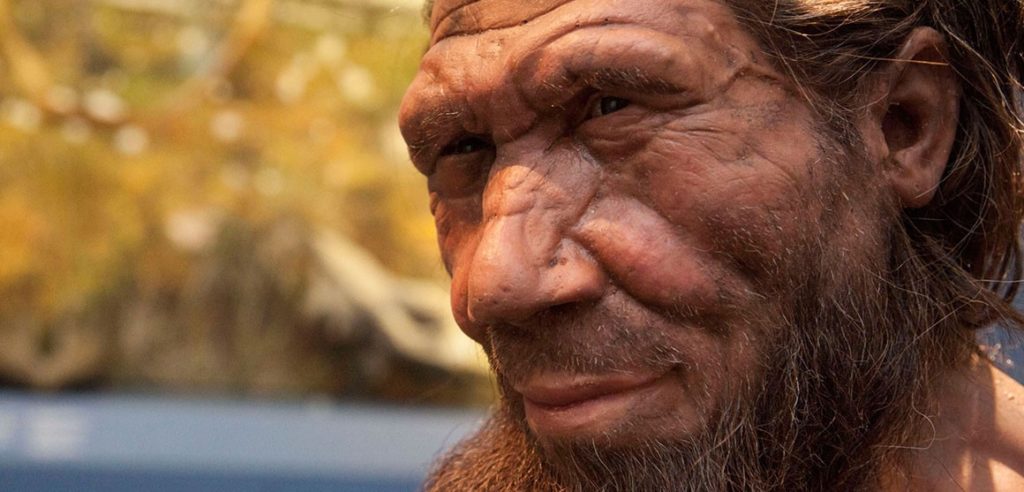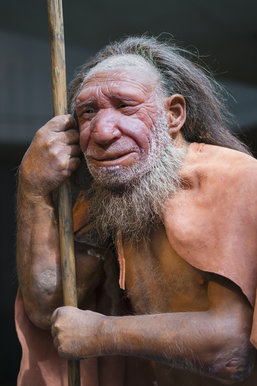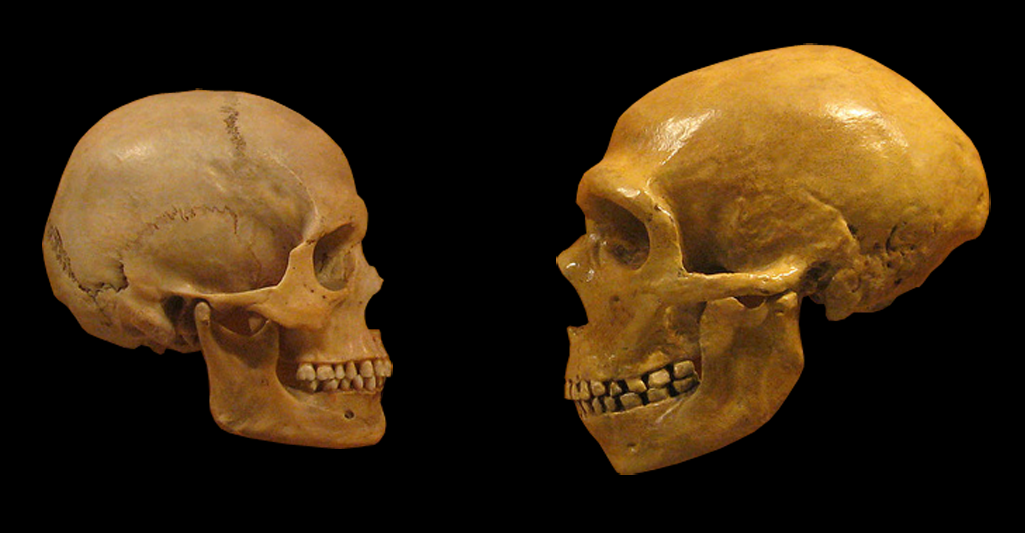Neanderthals R Us
Our closest living genetic relatives may be chimps and bonobos, but we have had even closer ones. Humans diverged from the ancestral line of primates to become a separate species about 5.5 million years ago. At that time we went our way, and the ancestors of chimps and bonobos went theirs. But those past 5.5 million years have seen a great variety of human-like creature of which we, Homo Sapiens, are only the latest. They have strange Latin names: ardipithecus, australopithecus, homo naledi, homo erectus and more. The most recent before us is homo neanderthalensis, the Neanderthals.(1)

The name “Neanderthal” (or “Neandertal”; the “th” is pronounced simply as “t”) comes from the place where this species’ skeletons were first discovered, the Neander valley (“Tal” in German), near Düsseldorf in western Germany. The Neanderthals show many similarities to us Homo Sapiens, but they died out about 40,000 years ago. We, obviously, have flourished. The question is, what is it about Sapiens that gave us the advantage?
We know quite a bit about this extinct species from archeology (“stones and bones”), of course, but also from DNA reconstruction and the new field of computational neuroanatomy. Sometime between 630,000 and 520,000 years ago the shared ancestors of Neanderthals and Sapiens diverged and embarked on separate evolutionary paths. Those who spread to the Middle East, Europe and western Asia eventually evolved into Neanderthals, whereas those in Africa gave rise to us modern humans, whom we have immodestly named Homo Sapiens, Latin for “wise human.”


Neanderthal Museum, Mettmann, Germany
At the time, during the Pleistocene epoch, the world was much colder; it was an ice age, although there were about a dozen warmer periods within it. In Africa, what is now the Sahara desert was periodically a moist and fecund savanna. Europe, bounded by glaciers in the north, was heavily forested. Humans in Africa became slender and hairless, adapted to remain cool in the heat and to be able to run long distances over grassy plains in pursuit of game. Humans in Europe became short and stocky, adapted to retaining body heat. Their upper leg was longer than that of Sapiens in proportion to the lower, probably an adaptation to climbing hills. Rather than running long distances to hunt, they sprinted, pursuing their prey in short bursts of speed. Their skulls were flatter and more elongated than ours, with protruding faces, prominent brows, large noses, and receding chins. Perhaps European fairy tales of gnomes and trolls are ancestral memories of human-like others who were shorter, lumpier, more deformed and—to modern eyes—uglier than we. Neanderthals lived in small and isolated populations of no more than about 3,000 individuals per region. Harsh climate and scarcity of resources likely contributed to keeping their numbers low.

Neanderthals were similar enough to Sapiens in biology and behavior that they interbred with us in several times and places between 100,000 and 40,000 years ago. About two percent of the DNA of modern humans of European descent come from Neanderthals. Asians and Melanesians have slightly more. Contemporary Africans have none. These genes seem to have contributed to lighter skin, lower blood levels of LDL (“bad”) cholesterol (thus reduced risk of heart disease) and higher levels of vitamin D (helpful in a gloomy climate). All of these would have contributed to genetic fitness. We should be grateful to our Neanderthal ancestors for helping the survival of our lineage.
Neanderthals had some of the same kind of cultural artifacts that Sapiens had: stone tools, ornaments made of bone and other materials and the like. Some of them buried their dead and may have painted designs on cave walls. But Neanderthal tool making changed little over hundreds of thousands of years; they were well adapted to their environment and had little impetus to change.
It is clear that Sapiens were smarter. Sapiens’ art, tools and cultural artifacts far outstrip those of the Neanderthals. Even if some cave paintings are Neanderthal—and that thesis is contentious—the famous paintings of lifelike animals in the caves of Chauvet, Altamira and Lascaux, clearly made by Sapiens, far transcend them. Neanderthal brains were about the same size as ours, but were constructed differently internally. They had more capacity devoted to vision and body control, with less left over for social interactions and complex cognition. We became smarter because of our environment. Sapiens evolved in the ancestral savanna for several hundred thousand years under changing climatic conditions while Neanderthals stagnated in Europe and western Asia. Sapiens were in constant contact with people from other tribes and became smarter because minds evolve by bumping up against other minds. Neanderthals, living in a harsher climate with less social contact, had less selection pressure to increase intelligence.
There are numerous conjectures about why Sapiens endured and Neanderthals went extinct. Perhaps our metabolism was more efficient. Perhaps we were less susceptible to Neanderthal diseases than they were to ours. Perhaps it was climate change: our physiology was better suited to the spreading grasslands of Europe as the forests receded, depriving the Neanderthals of their native habitat. Perhaps it was simply because we were smarter and could make better tools.
Yuval Harari plausibly speculates that Sapiens could outcompete their rival species because they had a greater capacity for communal social reality. Socially constructed realities such as shared mythologies and religion enabled Sapiens to coordinate the activities of a great many people, uniting bands of Sapiens more efficiently than relatively isolated Neanderthal tribes. Artifacts dispersed over many hundred miles indicate extensive Sapiens trading networks.
Such competition may well have been violent. It is not hard to imagine tribes of Sapiens warring against people who did not even look quite human, because we have a long history of warring against each other, who do. Sapiens bands would aggressively move in on the Neanderthals’ territory and chase them out or kill them in order to capture their resources. It would be a totally primate thing to do.
But competition didn’t have to be violent. Superior hunting techniques, especially in an environment that was becoming dryer and less forested, could have enabled Sapiens to capture more game, starving the Neanderthals out. The Neanderthals, facing food shortages, would have had to move away to find sustenance. After a while there was no place else to move to. It’s a sad story, really; it’s easy to feel a bit sorry for them.
Probably multiple causes contributed to Neanderthal decline, but our enhanced capacity to construct social realities stands out. That is quite a cognitive achievement, and understanding it is a key part of understanding who and what we are.
Philosopher John Searle calls socially constructed realities “institutional facts.”(2) They are facts that exist only by virtue of collective agreement or acceptance, and there are quite a number of them. Searle mentions money, property, marriages, governments, tools, restaurants, schools and many others. They exist only because we believe them to exist.
We don’t much notice socially constructed realities because they are just part of the background. We take for granted marriage, bankruptcy, nations, legal codes and lots of other things that don’t have physical existence (although they may well affect or be instantiated by physical things). They don’t have physical existence, but they are quite real in that they have real effects on people. Try telling the judge that you don’t have to obey the law because it doesn’t exist!
One of most prevalent socially constructed realities is morality. The details of what conduct is prohibited, allowed and required by the moral code may vary from culture to culture, but all cultures have sets of rules, whether stated explicitly or not, that specify how people are to act. And people in every culture—which is to say all people, as we never find humans in isolation—have internalized the moral code of their culture and have a conscience, a sense of right and wrong.
Because moral rules are socially constructed, they are subject to change if enough people agree. Over the years, moral codes have indeed changed for the better; we no longer tolerate slavery, for instance, and are becoming more accepting of sexual preferences that used to be thought depraved and sinful. As we learn to take the point of view of others, we promote kindness and compassion, which benefit all of us.
If we came across a band of Neanderthals today, hidden away in some remote valley, I hope we would care for them as much as we do for other endangered species. They were no less human than we, only different.
Notes
(1) There was a similar species in eastern Asia, the Denisovans, named after a cave in Siberia where their remains were first found. Their physique and lifestyle were probably comparable to Neanderthals. Also like Neanderthals, they went extinct shortly after Sapiens showed up in their territory. My comments about Sapiens’ cognitive superiority to Neanderthals apply also to Denisovans.
(2) Searle, The Construction of Social Reality, pp. 2, 28, 43-45.
References
Alex, Bridget. “Neanderthal Brains: Bigger, Not Necessarily Better.” Online publication http://blogs.discovermagazine.com/crux/2018/09/21/Neanderthal-brains-bigger-but-not-necessarily-better/ as of 17 October 2019.
Akst, Jef. “Infographic: History of Ancient Hominin Interbreeding.” Online publication
https://www.the-scientist.com/magazine-issue/infographic–history-of-ancient-hominin-interbreeding-66319
as of 30 September 2019.
Harari, Yuval Noah. Sapiens: A Brief History of Humankind. New York, Harper-Collins, 2015.
Hendry, Lisa. “Who were the Neanderthals?” Online publication
https://www.nhm.ac.uk/discover/who-were-the-neanderthals.html as of 13 October 2019.
O’Shea-Jhu, Dennis. “Short legs let Neanderthals climb mountains.” Online publication
https://www.futurity.org/short-legs-let-neandertals-climb-mountains/ as of 6 November 2010.
Scientific American various authors. “Evolution: The Human Saga.” Scientific American, September 2014 Volume 311, Number 3.
Searle, John R. The Construction of Social Reality. New York: The Free Press, 1995.
Stromberg, Joseph. “Science Shows Why You’re Smarter Than a Neanderthal.” Online publication
https://www.smithsonianmag.com/science-nature/science-shows-why-youre-smarter-than-a-Neanderthal-1885827/
as of 13 October 2019.
Tatersall, Ian. “Homo sapiens.” In Britannica Online Encyclopedia. Online publication
https://www.britannica.com/topic/Homo-sapiens as of 4 November 2019.
Than-Stanford, Ker. “Did disease buy time before Neanderthal extinction?” Online publication https://www.futurity.org/neanderthal-extincton-disease-transmission-2206732-2/ as of 14 November 2019.
Touropia. “10 Prehistoric Cave Paintings.” Online publication https://www.touropia.com/prehistoric-cave-paintings/ as of 12 November 2019.
Tuttle, Russell Howard. “Human evolution.” In Britannica Online Encyclopedia. Online publication https://www.britannica.com/science/human-evolution/ as of 4 November 2019.
Viegas, Jen. “Brain Reconstructions Suggest Reasons for the Decline of Neanderthals.” Online publication
https://www.seeker.com/culture/Neanderthals-may-have-gone-extinct-because-of-their-brain-morphology as of
13 October 2019.
Viegas, Jen. “Neanderthal DNA Influences the Looks and Behavior of Modern Humans.” Online publication
https://www.seeker.com/culture/behavior/neanderthal-dna-influences-the-looks-and-behavior-of-modern-humans as of 9 November 2019.
Wikipedia. “Neanderthal.” Online publication https://en.wikipedia.org/wiki/Neanderthal as of 6 November 2019.
Wikipedia. “Neanderthal behavior.” Online publication https://en.wikipedia.org/wiki/Neanderthal_behavior as of 6 November 2019.
Wikipedia. “Neanderthal extinction.” Online publication https://en.wikipedia.org/wiki/Neanderthal_extinction as of 6 November 2019.


Very nice – interesting.
The first thing that I noticed in the picture was the famous elongated head found around the world.
“Philosopher John Searle calls socially constructed realities “institutional facts.”(2) They are facts that exist only by virtue of collective agreement or acceptance….Searle mentions money, property, marriages,….We take for granted marriage,….we no longer tolerate slavery,” ….Bill M.
The elongated skulls found and stored for 1,500 years among the relics of MEDIEVAL Germany, ” genetically, they are different.” says geneticist Joahim Burger from the University of Mainz.
The hypothisis is that these were wealthy women married off for political and stratigical reasons.
There are other possiblities as well, such as gentic carry over from possible neanderthals or it was a religious custom carried on within a small tribe or cult of persons, or they were slaves that were kept as spoils from warring parties.
The Neanderthal genes are alive and well, lots of men as well as women still carry that strange formation of slanted high forehead and protruding lower jaw… Look around.”
https://www.sciencealert.com/mystery-strange-elongated-skulls-finally-solved-deformed-artificial-cranial-bavaria
The elongated skulls found and stored for 1,500 years among the relics of MEDIEVAL Germany ” genetically, they are different.” says geneticist Joahim Burger from the University of Mainz.
Thanks for this article, very interesting, hooked me on your blog.
I walked away wondering if some future human species may declare us ugly and kinda stupid after we are gone. After we are gone, that’s an interesting issue in itself. Your article helped me see that just as human individuals and human civilizations come and go, so do human species. Given all that’s happening today, it’s not so hard to imagine us gone.
This may be crackpot philosophy, but I’ve often wondered if UFOs are piloted by some future human species that has mastered time travel.
Neanderthal extinction was neither caused by Climate Change, nor the confrontation with our ancestors, the Homo sapiens. A new study explains what happened to the Neanderthals? Why they suddenly disappeared.
Scientists at the IBS Center for Climatic Physics have discovered that, contrary to popular belief, the Neanderthal extinction was not caused by abrupt climatic changes or by crossbreeding with Homo sapiens. According to new simulations of supercomputer models, the reason for the rapid disappearance of Neanderthals from 43 to 38 thousand years ago was competition for resources with our ancestors Homo sapiens.